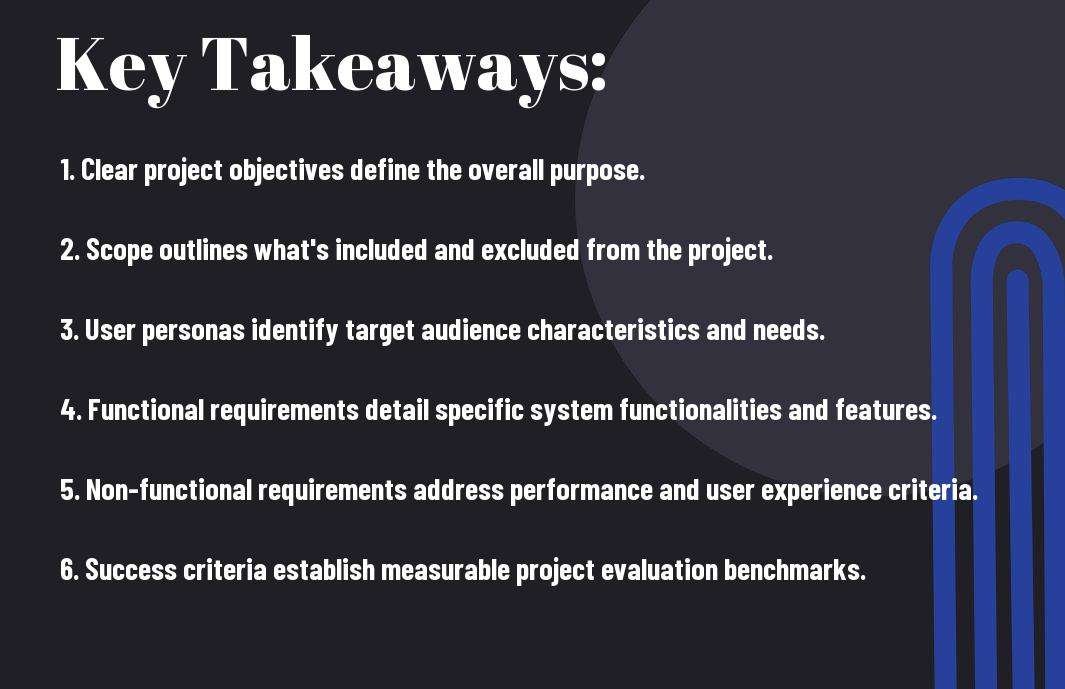Over my experience in managing projects, I’ve learned that understanding the key components of a Product Requirements Document (PRD) can significantly impact your project’s success. A well-structured PRD not only clarifies your project’s goals but also aligns your team’s efforts. This guide outlines the important elements you need to include, such as project objectives, user stories, and acceptance criteria. For a comprehensive look at crafting a solid PRD, check out How to Write An Effective Product Requirements Document.
Key Takeaways:
- Clear Objectives: Define specific and measurable goals that the product must achieve to align the team’s efforts and expectations.
- User Requirements: Include detailed descriptions of end-user needs and behaviors to ensure the product addresses real-world problems effectively.
- Specifications and Constraints: Outline technical specifications, performance criteria, and any limitations to help guide development and avoid scope creep.

Understanding the Purpose of a Product Requirements Document
While crafting a successful project, a Product Requirements Document (PRD) serves as a foundational tool that articulates the necessary elements needed to achieve your product vision. This document outlines what the product needs to accomplish, ensuring that all team members are on the same page. A well-structured PRD minimizes misunderstandings, aligns your team’s efforts, and ultimately leads to a more efficient development cycle.
Importance of Clear Requirements
Requirements must be articulated clearly to avoid ambiguity during the development process. When specifications are well-defined, they pave the way for focused discussions, streamline decision-making, and allow teams to work efficiently. This clarity helps to ensure that everyone involved understands the project goals and individual responsibilities, reducing the risk of miscommunication and rework.
Aligning Stakeholders and Objectives
Against the backdrop of diverse opinions and expectations, it is vital to align all stakeholders around common objectives outlined in your PRD. Doing so facilitates collaboration and fosters an environment where everyone’s inputs are valued, leading to a more cohesive end product.
Product alignment is about ensuring that everyone—from developers to marketing—is working towards the same set of goals. By clearly documenting requirements, you create a shared understanding that minimizes conflicts and fosters teamwork. When stakeholders are on the same page, the project can gain momentum, enabling you to allocate resources effectively and prioritize tasks that deliver maximum value. Moreover, aligning everyone’s expectations early on can prevent costly challenges later, thereby enhancing the overall success of your project.
Key Components of a Product Requirements Document
There’s a blueprint that defines a product’s trajectory, and that is the Product Requirements Document (PRD). It encompasses various components that shape the development process, ensuring that your project aligns with stakeholder expectations and market needs. Understanding these key elements will empower you to create a thorough and effective PRD, leading your team to project success.
Project Overview and Objectives
Components of a successful PRD include a clear project overview and well-defined objectives. This section serves as an introduction, laying out the scope, vision, and primary goals of your project. By articulating these elements, I help stakeholders grasp the project’s purpose and direction, setting the stage for focused development.
Functional Requirements
Before diving deeper into a project, I find it important to outline the functional requirements. These are the specific features, functionalities, and capabilities that the product must possess to meet the needs of its users. Understanding these requirements allows you to create a product that not only serves its intended purpose but also satisfies user expectations.
Requirements include detailed descriptions of what tasks the product must enable, the types of user interactions, and any data that must be processed. This clarity helps you avoid common pitfalls, ensuring your development team is aligned with the product vision, ultimately leading to a more streamlined and efficient development process.
Non-Functional Requirements
On the other hand, non-functional requirements encompass the quality attributes that define how the product performs. These include aspects like performance, security, usability, and scalability. You must identify these requirements to guarantee that the product operates effectively under various conditions.
Project stakeholders need to understand that non-functional requirements can significantly impact user satisfaction and overall system functionality. By articulating these needs, I can help prioritize them alongside functional features, ensuring a balanced approach that leads to a robust and reliable product.
Use Cases and User Stories
Along with technical specifications, I believe it’s vital to include use cases and user stories in your PRD. These narrative elements illustrate how users will interact with your product, providing context and meaning behind the requirements. By including these, you enable everyone involved in the project to visualize the end-user experience.
A strong focus on use cases can uncover user needs and vulnerabilities that might not be apparent through traditional requirements gathering. By telling the story of your users, you foster empathy within your team, driving a collaborative approach that ultimately results in a user-centered product design.

Best Practices for Writing a Product Requirements Document
For a Product Requirements Document (PRD) to effectively guide your project, it’s important to implement best practices that enhance its usability and accuracy. These practices include ensuring consistency and clarity, engaging in collaboration with stakeholders, and committing to regular updates and revisions. By following these guidelines, you can create a PRD that is clear, comprehensive, and aligned with your project goals.
Consistency and Clarity
An effective PRD is characterized by consistency in language and format, which helps prevent misunderstandings. Ensuring that all terms are used uniformly throughout the document and that the structure remains predictable allows your team to easily navigate and comprehend the requirements. Strive to maintain a clear and concise style to facilitate better communication.
Collaboration with Stakeholders
Any successful PRD involves input from all relevant stakeholders. Engaging with team members, clients, and subject matter experts fosters a sense of ownership and ensures that all perspectives are considered. This collaboration can uncover important insights that might otherwise be overlooked, leading to a more comprehensive understanding of the product’s needs.
Another significant aspect of collaboration is that it builds trust among team members and stakeholders. When you actively seek input and feedback, you create a culture of transparency that encourages ongoing dialogue. This involvement not only enhances the quality of your PRD but also reinforces your commitment to delivering a product that meets the expectations of all parties involved.
Regular Updates and Revisions
Against the backdrop of a dynamic project environment, your PRD must be treated as a living document. Regular updates and revisions are necessary to ensure that it accurately reflects any changes in project scope, timelines, or stakeholder requirements. By adopting a proactive approach, you can minimize the risk of miscommunication and ensure alignment throughout the project lifecycle.
And making it a habit to schedule routine reviews of your PRD can significantly improve its effectiveness. This practice not only keeps the document current but also allows for immediate incorporation of feedback and lessons learned. By routinely revising your PRD, you demonstrate a commitment to excellence and adaptability, paving the way for a successful project outcome.
Common Pitfalls to Avoid
Despite the importance of a well-crafted Product Requirements Document (PRD), many projects fail due to common pitfalls. These mistakes often stem from a lack of clarity, poor communication, and an overload of information that can confuse stakeholders. By being aware of these missteps, you can create a more effective PRD, ensuring successful project execution and delivery.
Ambiguity in Requirements
Between vague descriptions and unclear expectations, ambiguity can lead to significant misunderstandings among team members. When your requirements lack specificity, it becomes challenging for stakeholders to grasp the project goals fully, resulting in misaligned priorities and potential delays.
Overloading with Technical Jargon
On occasion, I find that excessive use of technical jargon can alienate non-technical stakeholders and hinder productive discussions. Clear communication is necessary, so using everyday language helps ensure everyone involved understands the project’s objectives and requirements.
Hence, striking a balance between providing enough detail and avoiding overly complex terminology is vital. Utilizing plain language allows all team members to engage in meaningful conversations, fostering collaboration and creativity. Additionally, it ensures that your PRD remains accessible, enabling stakeholders from various backgrounds to contribute effectively. A PRD should be a guiding document, not an insurmountable wall of jargon that leaves people feeling overwhelmed and disconnected.
Tools and Templates for Effective Requirement Documentation
Now that we’ve discussed the key components of a Product Requirements Document (PRD), let’s explore some helpful tools and templates to enhance your documentation process. You can dive deeper into the Key components of a Product Requirements Document (PRD) for a more comprehensive understanding.
Software Solutions
The right software solutions can significantly streamline your PRD development process. Tools like Confluence, Trello, or Asana provide excellent platforms for collaboration, organization, and tracking of requirements, ensuring you and your team stay aligned throughout the project lifecycle.
Industry-Standard Templates
Between various templates available, you can find some tailored to meet specific project needs while providing a solid foundation for your documentation. These templates offer a structured approach, ensuring that you incorporate all necessary elements without unnecessary complexity.
Plus, leveraging industry-standard templates can save you time and effort, allowing you to focus more on your project goals. These templates often include sections for user stories, acceptance criteria, and project timelines, ensuring you do not overlook critical components. Using them can enhance your communication with stakeholders and promote a shared understanding of project objectives, ultimately leading to more successful outcomes.
Conclusion
Hence, I believe that understanding the key components of a Product Requirements Document is crucial for your project’s success. By clearly defining the project scope, user needs, functional requirements, and acceptance criteria, you equip your team with the necessary tools to create a focused and effective product. Additionally, I emphasize the importance of collaboration and ongoing communication to ensure that everyone remains aligned throughout the project lifecycle. With a well-structured PRD, you are setting yourself up for a smoother development process and a more successful outcome.
FAQ
Q: What is a Product Requirements Document (PRD)?
A: A Product Requirements Document (PRD) is a comprehensive document that outlines the functional and non-functional requirements for a product. It serves as a guide for development teams, ensuring that everyone has a unified understanding of what the product should be. The PRD typically includes sections such as objectives, key features, user stories, and acceptance criteria, helping to align stakeholders and manage expectations throughout the project lifecycle.
Q: What are the crucial components that should be included in a PRD?
A: Essential components of a PRD include: 1) Introduction: This section provides an overview of the product and its purpose. 2) Scope: Clearly defines what is included in the project and what is not. 3) User Personas: Describes the end-users to ensure that the product meets their needs. 4) Functional Requirements: Detailed descriptions of what the product must do. 5) Non-functional Requirements: Criteria such as performance, security, and usability. 6) Acceptance Criteria: Specifies the conditions that must be met for the product to be considered complete. 7) Timeline and Milestones: Outlines project phases and deliverables. These components ensure a comprehensive understanding of the product’s intended features and functionality.
Q: How can a well-structured PRD impact project success?
A: A well-structured PRD can significantly impact project success by providing clarity and direction. It helps to prevent scope creep, as all stakeholders have a shared understanding of the project’s objectives and deliverables. By defining user personas and requirements, the team can prioritize features that align with user needs, leading to higher satisfaction. Additionally, a clear timeline and milestone framework enables better project management and facilitates communication among team members, ultimately resulting in a smoother development process and successful product launch.







